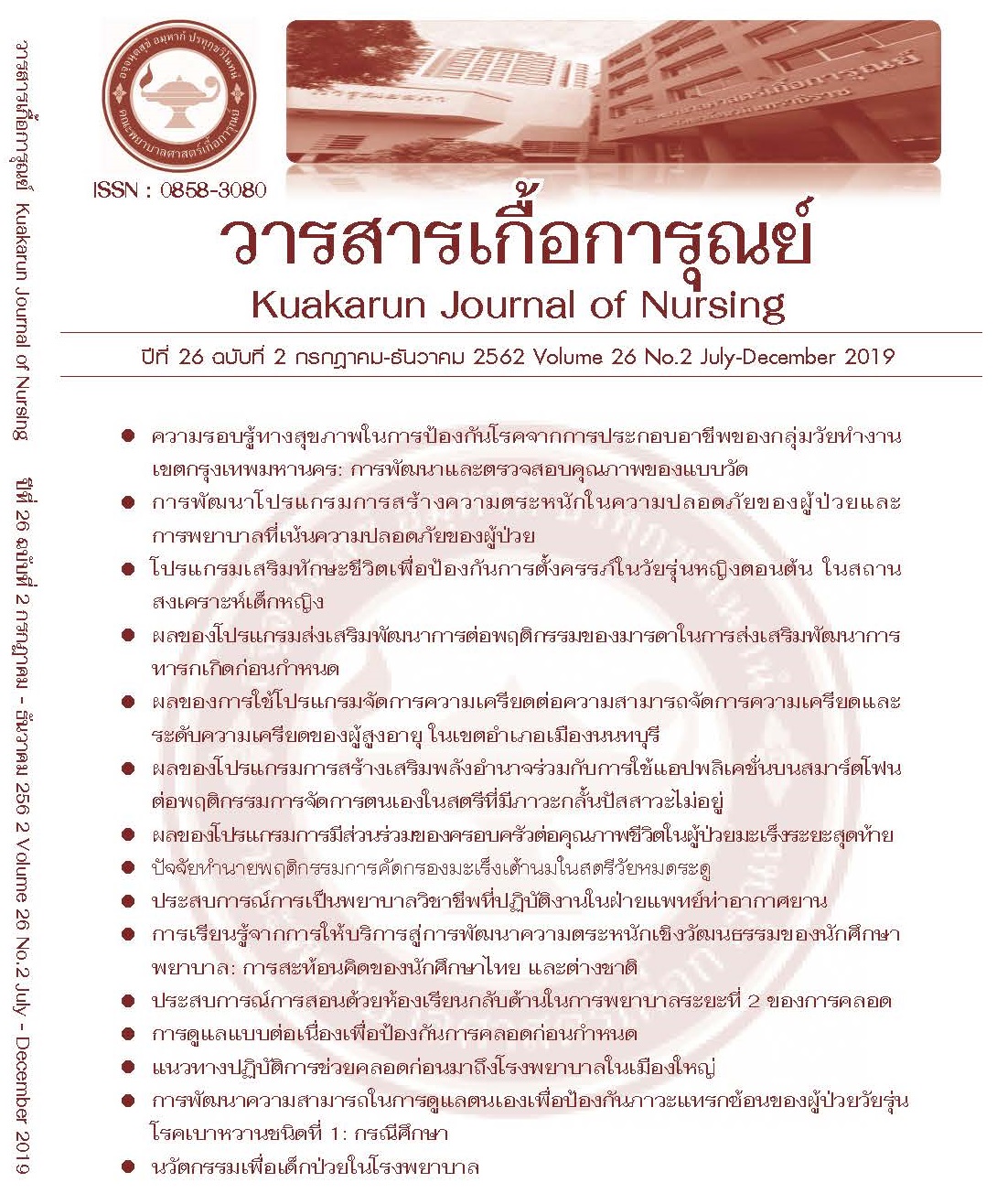Health Literacy for Occupational Diseases Prevention among Workers in Bangkok Metropolitan: Development and Validation of Health Literacy Scale Development and Validation of Health Literacy Scale
Main Article Content
Abstract
Occupational diseases in working-age groups can affect physical, mental, and economic status, that could lead to absence from work and loss of income. Health literacy is considered to be a key factor for developing an appropriate action to promote healthy behaviors and prevention of work-related diseases. Based upon the current literatures reviewed, health literacy measurement among Thai workers has not been found. The methodological research designed aim to developed The Thai-version of the Health Literacy Questionnaires of Occupational Diseases Prevention among workers (HLQODP) in Bangkok Metropolitan was tested for reliability and validity. The HLQODP, based on Sorensen’s conceptual framework and empirically validated by five experts. Then, the tool was tested in 30 samples with Cronbach’s Alpha coefficient. The HLQODP was analysed using descriptive statistics, Pearson ’s correlation coefficient and confirmatory factor analysis.
The results showed there were 600 workers participated in the research. Most of the participants were females (62%). The mean of the total health literacy was 4.23. The final version of the HLQODP had 20 items, with the Cronbach’s Alpha coefficient of 0.94. The Index of Item-Objective Congruence ranged from 0.60 to1.00. The confirmatory factor analysis showed that the model was fitted with acceptable fit using most criteria (χ2 = 388.99, df = 164, CFI = 0.99, GFI = 0.94, TLI = 0.99, RMSEA = 0.05) and also the 4-factors model was confirmed: 1) Assess 2) Understand 3) Appraise and 4) Apply. The Thai-version of the HLQODP had appropriated psychometric properties. It can be used to assess health literacy for occupational diseases prevention among workers.
Article Details
References
สำนักโรคจากการประกอบอาชีพและสิ่งแวดล้อม กรมควบคุมโรค กระทรวงสาธารณสุข. (2561). โรคจากการ ประกอบอาชีพ. สืบค้นเมื่อ 10 พฤศจิกายน 2561 จาก https://envocc.ddc.moph.go.th/ contents/ view/56.
Andersen, L. L., Clausen, T., Burr, H., & Holtermann, A. (2012). Threshold of musculoskeletal pain intensity for increased risk of long-term sickness absence among female healthcare workers in eldercare. PLoS One, 7(7), e41287. doi:10.1371/journal.pone.0041287
Briggs, A. M., Jordan, J. E., O’Sullivan, P.B., Buchbinder, R., Burnett, A. F., Osborne, R. H., & Straker, L. M., (2011). Individuals with chronic low back pain have greater difficulty in engaging in positive lifestyle behaviours than those without back pain: An assessment of health literacy. BMC Musculoskeletal Disorders, 12(161), 1-10. doi:10.1186/1471-2474-12-161
Chang, C.J., Yang, H.H., Wang, Y. F., & Li, M.S. (2015). Prevalence of sick building syndrome-related symptoms among hospital workers in confined and open working spaces. Aerosol and Air Quality Research, 15, 2378-2384. doi:10.4209/aaqr.2015.01.0040
Chantaracherd, P. (2015). The office syndrome: A potential risk factor of TMD and headache, maybe vice versa? Mahidol Dental Journal, 35(3), 265-272.
Diamantopoulos, A. & Siguaw, J. A., (2000). Introduction to LISREL: A guide for the uninitiated. London: SAGE Publications, Inc.
Fornell, C., & Larcker, D. (1981). Evaluating structural equation models with unobservable variables and measurement error. Journal of Marketing Research, 18(1), 39-50. doi:10.2307/3151312
Hair, J. F., Black, W. C., Babin, B. J., & Anderson, R. E. (2010). Multivariate data analysis: A global perspective. (7th ed.). Upper Saddle River, New Jersey: Prentice-Hall.
Hernández Martín, M. M., Romero-Saldaña, M., Pacheco Del Cerro, J. L., Alonso-Safont, T., Molina-Recio, G., & Meneses Monroy, A. (2019). Occupational and work-related disease underestimated and linked to temporary disability through primary health care services. Journal of Nursing Management, 27(6), 1140-1147. doi:10.1111/jonm.12785
International Labor Organization. (2019). World statistic. Retrieved August 20, 2019, from https://www.ilo.org/moscow/areas-of-work/occupational-safety-and-health/WCMS_ 249278 /lang--en/index.htm
Jordan, J. E., Buchbinder, R., Briggs, A. M., Elsworth, G. R., Busija, L., Batterham, R., & Osborne, R. H. (2013). The Health Literacy Management Scale (HeLMS): A measure of an individual's capacity to seek, understand and use health information within the healthcare setting, Patient Education and Counseling, 91(2), 228-235. doi:10.1016/j.pec.2013.01.013
McDonald, M., DiBonaventura, M. D., & Ullman, S. (2011). Musculoskeletal pain in the workforce: The effects of back, arthritis, and fibromyalgia pain on quality of life and work productivity. Journal of Occupational and Environmental Medicine, 53(7), 765-770. doi:10.1097/JOM.0b013e318222af81
Nunnally, J. C., & Bernstein, I. H. (1994). Psychometric theory. (3rd ed.) New York: McGraw-Hill.
Osborne, R. H., Batterham, R. W., Elsworth, G. R., Hawkins, M., & Buchbinder, R. (2013). The grounded psychometric development and initial validation of the health literacy questionnaire (HLQ). BMC Public Health, 13, 2-17.
Pituth, K. A., & Stevens, J. P. (2016). Applied multivariate statistics for the social sciences (6th ed.). New York: Routledge.
Polit, D.F. & Beck, C.T. (2017). Nursing research: Generating assessing evidence for nursing practice (10th ed.). Philadelphia: Wolters Kluwer.
Rushton, L. (2017). The global burden of occupational disease. Current Environmental Health Reports, 4, 340–348. doi:10.1007/s40572-017-0151-2
Sorensen, K., Brouche, S. V., Fullam, J., Doyle, G., Pelikan, J., Slonska, Z., & Brand, H., (2012). Health literacy and public health: A systematic review and integration of definitions and models. BMC Public Health, 12, 1-13. doi:10.1186/1471-2458-12-80
Takala, J., Hämäläinen, P., Saarela, K. L., Yun, L. Y., Manickam, K., Jin, T. W., … Lin, G. S. (2014). Global estimates of the burden of injury and illness at work in 2012. Journal of Occupational and Environmental Hygiene, 11(5), 326–337. doi:10.1080/15459624.2013.863131
Wong, B. K. (2012). Building a health literate workplace. Workplace Health & Safety, 60(8), 363-369. doi:10.1177/216507991206000806
World Health Organization [WHO]. (1998). Health Promotion Glossary. Geneva: WHO Publications.

